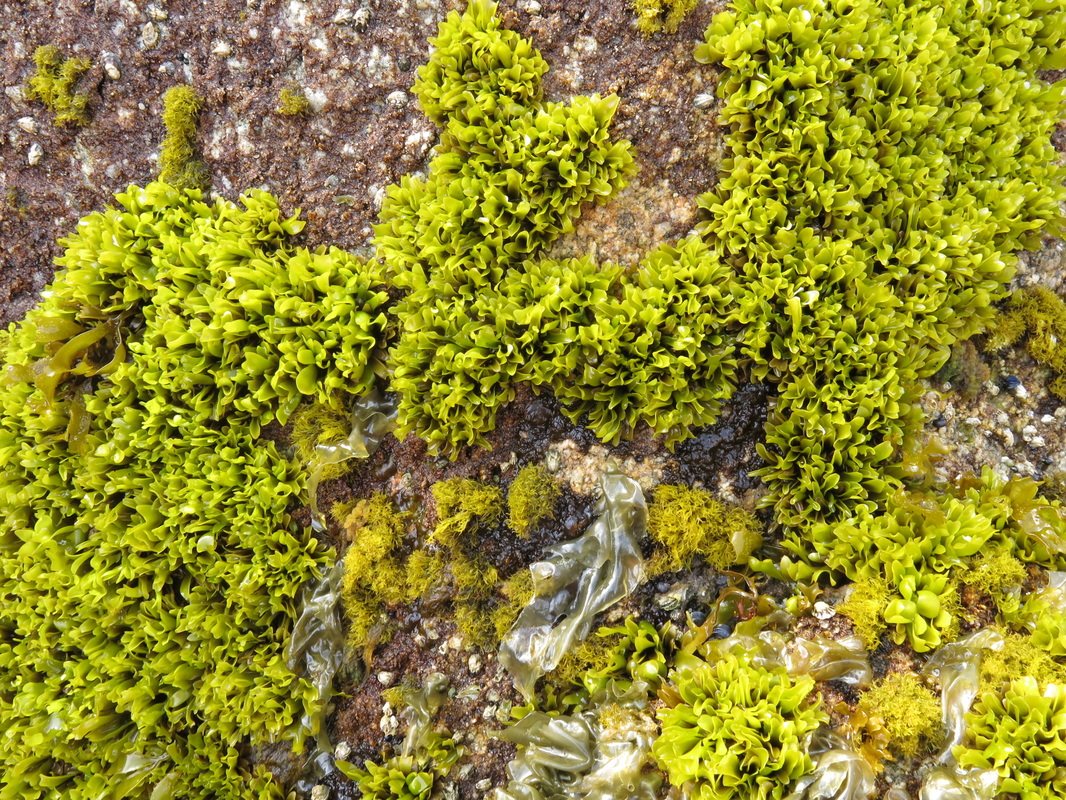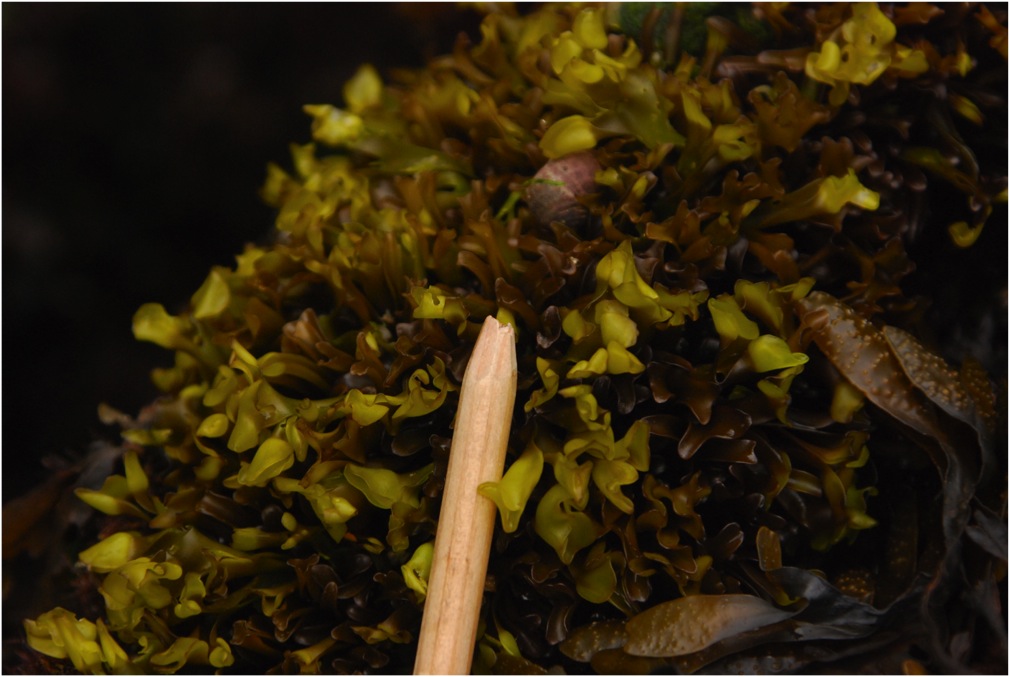Iridescent horn-of-plenty • Mazzaella parksii
Identification
Iridescent horn-of-plenty is a red seaweed but varies in colour from olive-green or golden brown to dark purple. It has clusters of thick, upright blades that are 3-5 cm tall, have a rubbery texture, and are usually divided into 2 or 3 rounded lobes. The blades bear cystocarps that form pimple-like bulges. The area where the blade and stipe meet is furrowed, and the lobes may appear somewhat wavy or curled. Many blades attach to a thin, encrusting holdfast. This holdfast is usually perennial.
Habitat & Range
This seaweed grows in dense clusters on open rock faces in the upper intertidal of exposed and semi-exposed coastlines. Its range extends from the Aleutian Islands in Alaska to Mendocino County in California. It is also is found on coastlines in northern Japan and the Kurile Islands in Russia.
Similar Species
Male Turkish washcloth (Mastocarpus papillatus) is similar in shape and colour, but its blades are more cartilaginous.
Intriguing Info
Mazzaella cornucopiae is a synonym of M. parksii, and, like its common name, refers to the species' resmblance to the Horn of Plenty, or Cornucopia.
Iridescent horn-of-plenty is a red seaweed but varies in colour from olive-green or golden brown to dark purple. It has clusters of thick, upright blades that are 3-5 cm tall, have a rubbery texture, and are usually divided into 2 or 3 rounded lobes. The blades bear cystocarps that form pimple-like bulges. The area where the blade and stipe meet is furrowed, and the lobes may appear somewhat wavy or curled. Many blades attach to a thin, encrusting holdfast. This holdfast is usually perennial.
Habitat & Range
This seaweed grows in dense clusters on open rock faces in the upper intertidal of exposed and semi-exposed coastlines. Its range extends from the Aleutian Islands in Alaska to Mendocino County in California. It is also is found on coastlines in northern Japan and the Kurile Islands in Russia.
Similar Species
Male Turkish washcloth (Mastocarpus papillatus) is similar in shape and colour, but its blades are more cartilaginous.
Intriguing Info
Mazzaella cornucopiae is a synonym of M. parksii, and, like its common name, refers to the species' resmblance to the Horn of Plenty, or Cornucopia.
References
Guiry, M.D. & Guiry, G.M. (2013). Mazzaella parksii (Setchell & N.L.Gardner) Hughey, P.C. Silva & Hommersand. AlgaeBase. National University of Ireland, Galway. Accessed 20/06/2013.
Guiry, M.D. & Guiry, G.M. (2013). Mazzaella cornucopiae (Postels & Ruprecht) Hommersand. AlgaeBase. National University of Ireland, Galway. Accessed 20/06/2013.
Lindberg, M. and Lindstrom, S. (2010). Mazzaella parksii. Seaweeds of Alaska. Accessed 20/06/2013.
O'Clair, R. and Lindstrom, S. Mazzaella parksii (Setchell et N.L. Gardner) Hughey, P.C. Silva et Hommersand. In Klinkenberg, Brian. (Ed.). E-Flora BC: Electronic Atlas of the Plants of British Columbia. Lab for Advanced Spatial Analysis, Department of Geography, University of British Columbia, Vancouver. Accessed 25/07/2014.
Authors and editors of page
Joel White, Kelly Fretwell, and Brian Starzomski (2014).
Guiry, M.D. & Guiry, G.M. (2013). Mazzaella parksii (Setchell & N.L.Gardner) Hughey, P.C. Silva & Hommersand. AlgaeBase. National University of Ireland, Galway. Accessed 20/06/2013.
Guiry, M.D. & Guiry, G.M. (2013). Mazzaella cornucopiae (Postels & Ruprecht) Hommersand. AlgaeBase. National University of Ireland, Galway. Accessed 20/06/2013.
Lindberg, M. and Lindstrom, S. (2010). Mazzaella parksii. Seaweeds of Alaska. Accessed 20/06/2013.
O'Clair, R. and Lindstrom, S. Mazzaella parksii (Setchell et N.L. Gardner) Hughey, P.C. Silva et Hommersand. In Klinkenberg, Brian. (Ed.). E-Flora BC: Electronic Atlas of the Plants of British Columbia. Lab for Advanced Spatial Analysis, Department of Geography, University of British Columbia, Vancouver. Accessed 25/07/2014.
Authors and editors of page
Joel White, Kelly Fretwell, and Brian Starzomski (2014).





